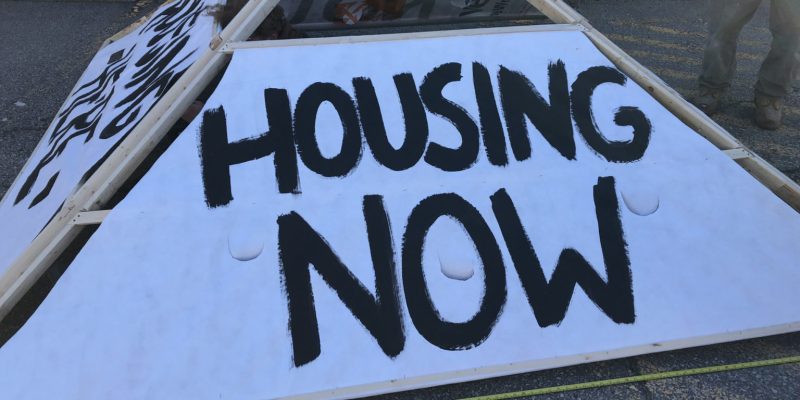We can’t address the housing affordability crisis without talking about the failures of the wealth redistribution system.

Frame of a roof with a white sign that has ‘Housing Now’ painted in black. Credit: Cathy Crowe / Cathy Crowe
Recently, I had the pleasure of attending Co-Ownership Opportunities and Ownership Options, a one-day conference at the Centre for Social Innovation’s Annex campus in Toronto, hosted by GoCo Solutions, an entity dedicated to providing knowledge, advice and connections for people navigating the process of becoming a co-owner of a residence.
A testament to the hard work and dedication of its principles, this group includes real estate agents, a mortgage broker and a lawyer. The diverse and well-attended event attracted coverage from CBC and Radio-Canada, among others.
Speakers at the conference drew on a wide range of backgrounds. Presentations by Hamid Sodeifi, Economist and Teacher at Sheridan College; and Michael Piper, Assistant Professor of Architecture and Director of the Master of Urban Design Program at the University of Toronto, widened the scope of the discussions, complementing the legal and financial information presented to the attendees.
Conference participants expressed various reasons for exploring co-ownership. Some were millennials looking to find co-owners, others were boomers trying to help their adult children into the market. Either way, the Toronto real estate market’s notorious affordability problem was top of mind.
For some, the conference was a disappointing realization. While co-ownership is a viable model that provides a possible path to home ownership for some, it is not an option for all. During a question and answer period, a mortgage broker was asked how a group of people who, for example, work in the retail or service industries, where wages are relatively low, might become co-owners. The mortgage expert noted that, while such a group might have the ability to qualify for and make regular payments on a mortgage loan, like any buyer, the group would not be in position to co-own until that group had saved up a down payment.
Given that down payments can represent up to 20 per cent of the purchase price of a new home, and that the average price of a new home (especially one big enough to accommodate multiple co-owners) is well over a million dollars, saving for a down payment remains a significant obstacle.
Having considered these facts, the next question posed to the panel was: “‘Well, what are people who work in retail or service to do?’ The response was a collective shrug. (One attendee was later overheard saying: ‘Your generation just has to accept that we live in a Capitalist society. Not everyone gets to own their home. In fact, Canada is unusual. It’s not like this in the rest of the world.’ Like I said, the conference drew a large and varied crowd.)
It seems then, that the group of people who are both interested in and qualified for co-ownership, is limited, stuck between those who can afford to purchase a home on their own and those would-be co-owners who are unable to obtain financing. A niche market, if there ever was one.
While the conference organizers were successful in keeping the discussion focused on relevant issues in the real estate market, the systemic failures of our present system for re-distributing wealth were largely ignored.
Designed by and for a rentier class, housing market affordability is inextricably tied to the labour market, tax policy, and municipal planning, to name but a few of the many factors that result in multi-million dollar vacation homes for some and an experience of homelessness for others.
How different might the housing market look if servers and retail workers were employed by workers’ co-operatives that owned, and shared in the profits of, those businesses that currently exploit them?
If a government-backed entity was given a mandate to provide down payment assistance to prospective co-owners, would it result in a new wave of co-ownerships? What does it look like if we put an end to the ‘housing as an investment’ mentality? I only hope to live long enough to find out.
 Subscribe to our RSS feed
Subscribe to our RSS feed Find us on Facebook
Find us on Facebook